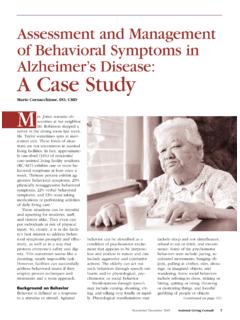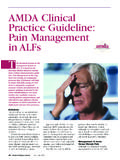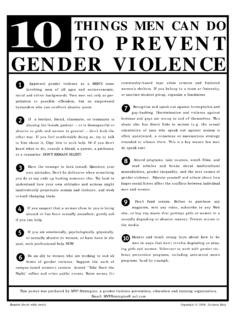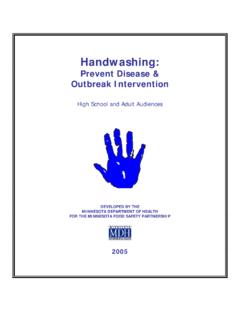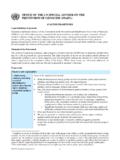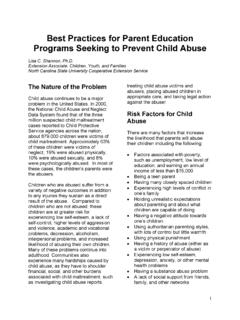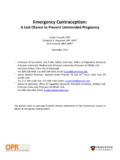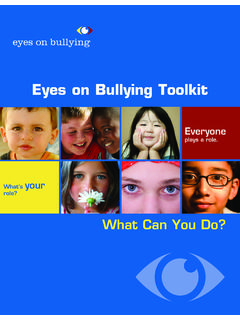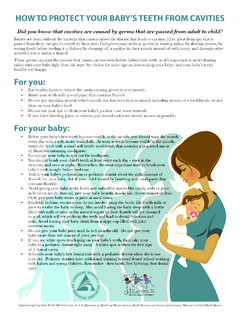Transcription of Designing Strategies to Prevent Falls
1 November/December2006 AssistedLivingConsult13 Oneof the une xpected sideeffectsof therapidgrowt h of assist edliv ing(AL)is th e increasingrecognitionthat fallsare a majorpr ises ti matedthatupto 50%of res i-de ntsexperienceoneor morefa llsan ofthese fallsres ultin seriousinj ur ie srequiringmedi calattention(eg,sp rains, jointdi sl ocations,head tr au -ma, wristandhipfractures) . Otherconse qu encesof fal lingincludelo ssof mobilityandfunction,depres -si on , an d se lf -i mposedfuncti onallimitat io ns causedbyfearof fall ing,whichcanincrease theri sk of , thepro b-lemof fa llingin ALis drawingin -crease d recogni ti onfromregulator s,su chas theJoi nt CommissiononAccreditationof HealthcareOrgani -zations(JCAHO).1 JCAHO recentl yan nounced it s 2007Na tionalPati en tSa fe ty Goals, (s eepage35)whic hap ply spe ci fi cally to accreditedALfacil ities,andincl udetheneed to : Reduc e theri skof residentharmres ulti ngfromfal ls.
2 Implementa fallreductionpro -gram inc ludinganevaluation ofth e eff ec tiveness of is unders corestherealri sk forfa ll s in ALandtheneedto ad dr essth e th isarticle is to provideALwi th practi-ca l gu id ancein developingan ap -pr oa ch to Co mpone ntsofFa ll PreventionPr eventingfalls amongresidents inALrequi resa multifacetedap yto preventfalls, to a largeex -tent, is dependentupon staffad herin gto a cli ni cal processor pr ac ti ceof careregardi ngfal l pre-venti on , whichass is tsstaffin id entifying factors co ntr ib ut-ingto fall s an d fin di ngsolutio nstoreducin g theri skof fal lin g. Conse-quentl y, ha ving in pl aceanorg an -iz edcl ini ca l ap proachor processrepres entsthefo un datio n of an yfallpreventi onprogram. Develop-ingeducational pro grams an d pro -vi di ngadmin is tr ativesu pport fo rfallpr eventio n activitiesar e eq ual ly im portanten -ab li ngfactors for a su c-cessful inical Pro cessTh e necessar y co mponen ts of a bestpr actice ap proachto fallpreventio nco ns is t of iden tifyi ngres id en ts atris k, communicating th is ris k stat usto al l staff, targeting in ter venti on sai medat red uc in g ris k, monito rin gtheeff ec t of int erventio ns, an d eval-uating res id ents post-f ssi ng fall RiskThepurpose of ris k assessment is toidentifythoseresidentsmost likelyto fallandraise staffawarenessofDesigningStrategiestoPre ventFallsRei n Ti deiksaar, PhD14 AssistedLivingConsultNovember/December20 06fallris k.
3 Therationaleis thatif re si -dents at highris k of fallingcanbeide nti fie d, thenappropria te interv en -ti onscanbe ins titutedto minimizetheir riskof , con -ducti nga fallriskassessmentre pre-sents anim portantstartingpo intinat te mptingto reducefalls. In addi-ti on,al l re sidentswhofallshouldre -ceiv e a post-fallas thisas sessmentis to dis -coverwhat caused thefallandtopr event anotherfal l , onpa ge12of thisis RiskOnce a resident s riskof falling hasbeenid entified,it is cr ucialth at hi sor herris k st atusan d specific ris kfac tor s ar e co mmun icatedto allstaffinvolved. Pr eventable fallri skfac tor s ar e sho wnin Table 1. Com-munic ati onof fallris k canbeac hievedby meansof co lor edde-cal s (i e, pl acing symbo ls su chas afallingleafor st ar onth e res id en t'sch art , or onthebedroom wallab ovethebed), co lo redwr is tb an ds,an d/ or dail y shi ft repor ts.
4 In thi sway,everyone in thefacility knowsthatresi dents wearin g a co lo redwristband, for example,ar e at ris kof fal li ng. Mu lt id is cip lin ary Eval uat io nAft er completinga fallri skas ses s-mentandidenti fying specific ris kfactors, anat tempt sho uld be mad eto id en tif y the und er lying cause orcauses of al l ris k factors iden tif id en ts mayhavemultip leris k fact ors, mul tid is ci pli nar y ref er -ral an d evaluat io n ar e example,if int er nal ris k factorshavebeenid en tified, a referral tothe resi dent s pri mary med icalpro vider fo r further evaluat ion is in-dicated . If th e res id en t has im pair edmobilit y or a gaitandbalancepro blem, thenref er ral to a physi caltherapis t shou ld be mad e. If ext er -nal or en vironmental fact ors havebeenid en ti fied, th enanoccupa-tio nal or physicalth er ap is t ref erralshoul d be co nsid er ed(ie,alt houghnursi ngstaffmayevaluate unsaf eTabl e ll Ris k FactorsMostfal ls areno t accidental(i e, a fallcausedbyaresidenteithersl ippingon a we t fl ooror trippingov er anobjecton thefloor), butaredueto anu mberof interactingriskfac torsthatarepotent te rna l or He alt h Fa ctors Rece nt fall s (a hist or y of fallsis th e bestpredictoroffu turefal ls ) Poo r visi on(cataracts,maculardegeneration,gl au coma) Lowe r extremi ty dys function (arthritis,musclewe akness, impairedsensor y function) Un ste ad y gai t/balance(stroke, Parkinson 's di sease, etc.))
5 Uses cane/walker(ambulationaidsarea markerforun derlyinggait/b alance disorders) Elimin ati onproblems (excessivenighttimeurination,in con ti ne nce) Alteredcognit ion(dementia,depression,agitation) Fearof fall ing(leads to over- precaution,fearofwalking, andconsequently,weakness,poorbalance,an d in creased fal l risk) Poly pharmacy(4 or moreprescriptiondrugs) Medic ati onsi de effects(es peciallydrugsthataffectthecentralne rvoussy st em,suchas sedativesandtr an quiliz ers) Mobili ty impairment(bed,toilet,andchair/wheelchai rtr an sf ers) Foot de formiti es (corns,calluses , bunionsthatmightbedestabili zi ngthegait)Ext ern al or En viron me nt al Fact ors To ile ts (la ck of eq uipmentfor support,suchas grab bars) Furnishin gs (i nappropriate bed/chairhe ights ) Fl oors(l oo se or thick-pilecarpeting, slidingrugs,highly polish ed or wetground surfaces) Poorlighting (l ackof nightlights) Footwe ar (il l-fi ttin g shoes,slipperysoles) Assisti ve devi ce s (improperan d/orbrokencane,walke r, or whee lch air) Be d rai ls (rather th enpreventingfalls,bedrailsincreas e ri sk forinjuriousfalls) Clut ter in roomsor hallwaysBe havioral Fac torsCert ai n re sident activitiesor decisions mayincreasetheri sk of fal ls.
6 Examplesare: Walki ng in stocking feetor in footwearwithhighheels Rus hing to thebathroom(especiallyat night whennotful ly awakeor when lightin g maybe inadequate) Fai ling to us e a cane or walkerforbalancesupport Exh ibiti ng un safebehavior(overestimationof one sab ilities to se lf-t ransferan d ambulate,poor safetyawareness, desi re not to bother staffforassistance,an d re sistance to care)Sit uat io nal Fac tors Ne w ad mi ssion /post- fall (many fall s occurduringthefi rs t week aft er ad mission an d immediately followingafal l) Post-meal times (n eedfo r toileting). Ni ghttimehours(manyfal ls occurat night;oftenwhile travelin g to th e bathrooman d/or transferringfrombed) Acute diseases an d/orch an ge in condition(eg,urinaryinfe ct ion , pneumonia,acutedehydration,CVA,TIA,acute medicat ionreaction, suddenhy poglyce miaorhyperg lycemi a, etc.)
7 November/December2006 AssistedLivingConsult15en vironmentalconditions,thereof -te n is aninterplaybetweenun saf een vironmentalconditionsandun -sa fe resi dentmobilitythatmayre-qu irea th erapist). Identifiedri skfa ctors and theresultsof subse-qu entmult idisci plinaryevaluationsserveas thebasisforselectionofin ter vention s or str ategies aimedatreduc in g fallris re Plan nin gA fal l pr eventionpro gramis usef ulonly if aneffectivetr eatmentor in -ter ventionis eff ec -ti ve,in ter vention s needto be in di-vi du ali zed, accord in g to th e resi -dent s needs, an d targetedto id enti-fiedris k factors andmult id is cipli -nary evaluat io ns. It is im po rtan t toremember that as ris k fact orsch an ge, in ter ventio ns mayhavetoch an ge as wel l. A li st of mul tidisci -pli nary strategiesan d recommen d-Me dic al Stra tegies Diseasemanagement(treatacute/chroniccond itionsass oci ated wi th fal l risk) Medic ati onmanagemen t (attemptto eliminatemedicat ions thatareas sociatedwithfalls) Injurypreventi on(test forosteoporosisandtreataccor dingl y).
8 Nur sing Stra tegies Antici pator y care(anticipate re sid ent stoiletingneeds,hunger, thi rst , thosene ed s, as appropriate ) Su pervisi on/ob ser vation(monitorat-riskresidents andpr ovideassistance withambulation/transferswhenne ce ssary) Sc heduledtoil etin g (cuean d/ or assistresidentto thebathroomeve ry 2 hours, an d beforeandaf teractiviti es andmeals ) Eyeglasses/hearingaids(makesureth at eyeglassesarecl eanan d thathearingaidsareoperatingproperl y andworn ap propriatel y) Medic ati ons(watchresidents onnewmedicationsandloo k forsid e effe ctsth at mayleadto Falls ) Mentalst atuschanges(payattentionto suddenand/or subtle changesin residentbe havior thatmayinc reasefall ris k) Mobili ty devi ce s (makesurethat canes,walk ers,an dwhee lc hai rs arein go odcondition).Re hab ili tat ion St rate gie s Exercis e programsto improvemuscle toneandbuildst rength Dailyfloor ambul ationan d walkinggroupsto maintainmusclestre ng th /balancestability Re sident-specifi c exercise/training to improvebalance,gait,andsaf e transfers Ambu lati onde vices(as ses s needforcaneor walker;ev aluatecanes andwalkersto en suretheyaretheappro pri atetype, heightan d weight; teach residentho w to usecane or walkercorrectly) Wheel ch airs(as sessneedforch air;evaluatechairstoen surethe y areth e appropriatetype, height andwe ight; teachres id en t howto usechaircorrectly)En vir on ment al Strat egie s Lighting(keepar ea s where residents walkwell-l it, makesurethatli ght switchesor pull -co rd s areeasily accessible ).
9 Tabl e ti di sciplinaryStrategies and Fa ll Pre ven ti on In terventions Fl oors(cl eanupspillsimmediately,keepall floorscleanand we ll-s we pt , usenon -slipfloorwaxor nowaxat allto preve nt sli pping, keepwalkwaysfreeof clutterandob stacl es) Rugs/carpets (re moveor replacesmallslidingthrowrugs, ch eck thatbathroomrugshaverubbernon-sk idbacking, ens urethat all carpeting is well-securedandthat edges lie fl at ) St ai rways(maintainst urdyhandrailsto supportbal an ce,us e non -skidstairtreads,keep themwelllitan d fre e of cl ut ter) Bathrooms(i nstall han drailsin th e tubandshowerandaround the toil et, in stalla hightoiletseatto makesitting an d stan di ng saferan d easier,us e non-skidstri ps in the bat htubandsh owerto preventslips) Furniture(arrangefurnitureto allowforwidewalkingspaces, especial ly if residents useassistivedevicessuchas a cane or walker).
10 Be ds (adjus t to a height th at allowsresidentto sit andri se eas ily, beds shouldbesecuredto preventslippingor slidingduri ng use) Chai rs (s eatheigh t shouldallowresidentto sit an d riseeas ily, ch ai rs shouldbesecuredto preventslippingorslidin g duri ng us e) Footwe ar (wear low-heeledsh oeswithnon-skidsolesthat fi t sn ug ly;avoidfootwearwiththick,heavysolesthat cancat chonun evensurfaces;avoidwalkingwhile we ari ngsocksan d stockings,whichareslippery) Outdoorsurroundings(k eepoutsidewalkwaysandstai rs cl earof debris,leaves,sn ow,andice ).Equipment Strat egies Be d/ch airexi t al arms(alarmswillnotpreventfalls,butwi ll al ert caregi ve r to a probleman d allowthemtore spond morequickly) Be d side rai ls (bedrailsusedas en ab lerscanassistre sidents wi th safebedtransfers) Hip protect ors(specially designedunderwear/sweatpants to preve nt hip fractures) Be d side commodes(makestoiletingeasierforre sidents wi th uri naryfrequency; makessi ttingandstan di ng safe r an d easierfo r residentswithunsteadybal an ce).
